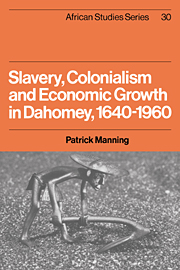Book contents
- Frontmatter
- Contents
- Maps
- Tables
- Figures
- Preface
- 1 Slavery, colonialism and economic growth, 1640–1960
- 2 The Dahomean economy, 1640–1890
- 3 Struggles with the gods: economic life in the 1880s
- 4 Production, 1890–1914
- 5 Demand, 1890–1914
- 6 Exchange, 1890–1914
- 7 The alien state, 1890–1914
- 8 Social struggles for economic ends, 1890–1914
- 9 The mechanism of accumulation
- 10 Capitalism and colonialism, 1915–60
- 11 The Dahomean national movement
- 12 Epilogue
- Notes
- Appendix 1 Export revenue from Dahomey, 1640s–1950s
- Appendix 2 Slave exports by ethnic origin
- Appendix 3 Population loss due to slave exports
- Appendix 4 Foreign trade of Dahomey
- Appendix 5 Foreign trade indices
- Appendix 6 Rainfall
- Appendix 7 Fiscal flows
- Appendix 8 Money supply of colonial Dahomey
- Bibliography
- Index
8 - Social struggles for economic ends, 1890–1914
Published online by Cambridge University Press: 26 October 2009
- Frontmatter
- Contents
- Maps
- Tables
- Figures
- Preface
- 1 Slavery, colonialism and economic growth, 1640–1960
- 2 The Dahomean economy, 1640–1890
- 3 Struggles with the gods: economic life in the 1880s
- 4 Production, 1890–1914
- 5 Demand, 1890–1914
- 6 Exchange, 1890–1914
- 7 The alien state, 1890–1914
- 8 Social struggles for economic ends, 1890–1914
- 9 The mechanism of accumulation
- 10 Capitalism and colonialism, 1915–60
- 11 The Dahomean national movement
- 12 Epilogue
- Notes
- Appendix 1 Export revenue from Dahomey, 1640s–1950s
- Appendix 2 Slave exports by ethnic origin
- Appendix 3 Population loss due to slave exports
- Appendix 4 Foreign trade of Dahomey
- Appendix 5 Foreign trade indices
- Appendix 6 Rainfall
- Appendix 7 Fiscal flows
- Appendix 8 Money supply of colonial Dahomey
- Bibliography
- Index
Summary
Giscard, the administrator of Abomey cercle, had been chided by the governor in Porto-Novo for writing inadequate reports. So in May of 1910 he wrote a long and flowery report, in the course of which he announced that in order to reduce the amount of labor necessary to clear the roads each year, he had instructed the people of the cercle to walk abreast of each other, across the full width of the roads, rather than in single file. Three years later at the same post another administrator, first complaining of the ‘grumblings of students,’ soon realized that he faced a broad movement in reaction to the zealous labor recruitment of an appointed chief. In neither of these cases was the sequel recorded: they were added to the long list of unresolved disputes reflecting the social strains brought by French rule in southern Dahomey.
Since the French state itself was the biggest change in the economy and society, it brought the most strains and the most complaints. In its role as arbiter, the state also entered into conflicts it did not initiate – often redefining them as it did so. Further, since the state kept most of the records, its role in social conflicts is highlighted and exaggerated. Available documents thus tend to impose an anlysis of ‘the government’ vs. ‘the people’ which, while unquestionably the major element of the colonial situation in Africa, was only part of a wider network of social interaction.
- Type
- Chapter
- Information
- Slavery, Colonialism and Economic Growth in Dahomey, 1640–1960 , pp. 187 - 216Publisher: Cambridge University PressPrint publication year: 1982

